
Welcome to our forum! Membership on this board is by invitation only.
|
| View previous topic :: View next topic |
| Author |
Message |
| lilly
Site Admin
| | Joined: 25 Aug 2005 | | Posts: 196 | |
|
 Posted: Wed Jan 14, 2009 4:40 am Post subject: The benefits of the Forward Bend Posted: Wed Jan 14, 2009 4:40 am Post subject: The benefits of the Forward Bend |
 |
|
The benefits of the Forward Bend - stretching the spine forward
Benefits
-stretches the hamstrings, upper and lower back
-strengthens knees and thighs
-reduces stress, depression and fatigue, sooths the mind, increases stamina
-anti-ageing
-it is very beneficial for cases of constipation, asthma, osteoporosis, sinusitis, high blood pressure
-enhances balanced thyroid functioning
- stimulates kidneys, liver and pancreas.
-promotes energy and blood circulation
-improves digestion
Bladder meridian
The forward bend pose stimulates the bladder meridian ( the longest meridian, connected to every organ in the body) which contains 134 acupuncture points. Headaches, pain in the neck, shoulder pain, pain in the upper and lower back are related to blockages in the bladder meridian. When body catches a cold or we become ill, afraid, tense, the �cold� energy enters the bladder meridian.
Standing Forward Bend

- Feet together solidly on the ground
-inhale as you lift your arms up overhead, exhaling swan dive forward from your hips
-crossing your arms, interlock them at the elbows and just hang
-keep knees straight, but not tense , lift your knee caps, keep the sitting bones lifting
-feel your body stretching
-breath in this pose for at least four breaths and then roll up
-the movement is slow, fluid, in a relaxed manner
-through this movement observe your breath
Seated forward bend

-On the inhalation lift both arms up over head, stretching your spine up
-lean forward from your hips, trying to grasp your feet or shines.
-keep your spine and legs straight.
-think more of lengthening the spine then how far you get in this pose.
-the gaze is towards your toes.
-breath at least four times into this pose.
-feel your body stretching
-repeat at least couple of times.
-if you are not able to reach your toes, clasp your knees, shins or ankles
-the movement is slow, fluid, in a relaxed manner
-through this movement observe your breath
Caution
If you have a back injury or if tension is felt in the lower back practice this pose softening and bending your knees
Never exaggerate or force the movement, but do not inhibit it, find your balance, let it be.
Lilly

_________________
http://www.natures-blessings.org/OrgoneFeetChakraBalancers.htm
http://psychicspiritinyou.com/balance-your-chakras-free-ebook/
http://cosmicvibes.podomatic.com/
Last edited by lilly on Sat Jun 25, 2011 10:43 pm; edited 1 time in total |
|
| Back to top |
|
 |
| lilly
Site Admin
| | Joined: 25 Aug 2005 | | Posts: 196 | |
|
 Posted: Wed Jan 14, 2009 4:40 am Post subject: Posted: Wed Jan 14, 2009 4:40 am Post subject: |
 |
|
Sharing an interesting email about forward bend pose
--------------------------
Lilly,
I have something useful you might add to your bending forward post, it has to do with the 6th Tibetan Rite(the "secret" rite that comes after doing the 5 Tibetan Rites exercises).
Click Here for a link explaining, with animations, the rites and their practice. I'll put in this email the 6th rite, for ease.
6th Rite
Deep Breathing:
Stand comfortably and exhale as you bend from the waist, placing your hands on your knees. Expel the last bit of air from your lungs and without taking in new breath, return to an erect position. Place your hands on your hips, with fingers to the front and press as hard as you can while sucking in the abdomen. This will raise your shoulders and chest. While holding in the abdomen, also squeeze the pubococcygeal muscle up to emphasize the upward thrust. Hold this position and bring your closed eyeballs to the point between the eyebrows so that all this lower chakric energy will rise up to the highest centers. When you must take a breath, breathe in through your nose and then exhale through the mouth as you drop your arms down to your sides to relax. Take in several normal breaths through the nose and mouth before beginning again.
Enjoy.
Lionil
-----------------
thank you for sending me this, Lionel,
I will repost it. Interesting enough, i tried the rites myself, they are very similar with yoga poses I do, Constantin incorporates few of them in his daily exercise. We have Peter Kelder's book "Ancient secret of the Fountain of youth" where he explains the tibetan rites. Good stuff. 
take care,
Lilly
_________________
http://www.natures-blessings.org/OrgoneFeetChakraBalancers.htm
http://psychicspiritinyou.com/balance-your-chakras-free-ebook/
http://cosmicvibes.podomatic.com/ |
|
| Back to top |
|
 |
| lilly
Site Admin
| | Joined: 25 Aug 2005 | | Posts: 196 | |
|
 Posted: Wed Jan 14, 2009 4:41 am Post subject: Posted: Wed Jan 14, 2009 4:41 am Post subject: |
 |
|
source: http://home.acceleration.net/clark/COOL938/Email.Essays/Tibetan.Yoga/Five.Rites.html
The Five Tibetan Rites is a yoga routine based on a ritual of exercises discovered in the early 1900's, by a British army colonel, Colonel Bradford, who was living in a Himalayan monastery. They are practiced around the world and are said to prevent aging. In 1939, Peter Kelder published "The Original Five Tibetan Rites of Rejuvenation," which helped spread the rites in the western world. Mr. Kelder has since updated the book "The Eye of Revelation - The Original Five Rites of Rejuvenation," Borderland Sciences Research Foundation, 1989, ISBN 0-945685-04-1.
The rites are comprised of five different movements (with a sixth added for good measure), with each movement performed up to 21 times (Tibetans believe 21 is a perfect, mystical number). It is best to start with 3 repetitions of each exercise and gradually increase the repetitions. The entire routine can be completed in less than 10 minutes.
For thousands of years, medical practitioners have maintained that the body has seven principal energy centers which correspond to the seven endocrine glands, also known as chakras. Chakras are essentially energies within spinning vortexes. As a vortex is increased, the life force becomes stronger and more directed.
Recent medical research has uncovered convincing evidence that the aging process is hormone-regulated. The five ancient Tibetan rites are said to normalize hormonal imbalances in the body, thereby holding the key to lasting youth, health, and vitality. The rites stimulate the energy system in the body, wake up the chakras, and get energy moving from your core outward to your extremities. The theory behind the rites is that your Kundalini (spiritual energy) is stored and lies at the base of your spine and that these rites access that energy in a very efficient, fast, and user-friendly way.
An important part of the Tibetan exercises is a conscious synchronization of breathing while performing physical activity. Before beginning the exercises, practice the basic 4 - stage breathing technique.
Inhale.
Hold filled lungs.
Exhale.
Hold empty lungs.
No exercise should be so intense that it makes you feel exhausted. For example, if you are "loosing your breath", it indicates that your body is in an anaerobic (low oxygen) condition and that you should slow down. If you can not talk normally after performing an exercise, you should slow down. When performing the exercises, the main emphasis should be on breath synchronization and fluency, rather than on speed and number of repetitions.
Some call these rites isometric exercises. Although they are helpful in stretching muscles and joints and improving muscle tone, this is not their primary purpose. A slow vortex causes that part of the body to deteriorate, while a faster one causes nervousness, anxiety, and exhaustion. Abnormal vortexes produces abnormal health, deterioration, and old age. The rites normalize the speed of the spinning vortexes by keeping them spinning at the same rate and working in harmony.
Here are the Five Tibetan Rites and how they work on the body (remember to breathe deeply using the diaphragm during the movements).
Rite 1
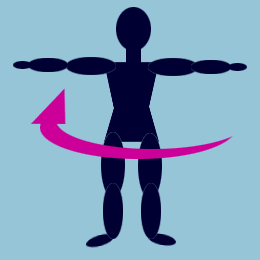
The first rite is the practice of spinning, which effects the emotional body by speeding up the vortexes. Children naturally spin while playing. As one spins clockwise, Lamas say that negative residues are flung out of the body and the bridge is strengthened between the left and right hemispheres. Spinning stimulates the body's energy system and wakes up the chakras.
Spinning:
Extend your arms out to the sides and spin (in a clockwise direction). Go as fast as you can without losing control (slow down or stop if you get dizzy). Try to do 21 revolutions.
Follow your right arm so that you spin around to your right. As you begin to spin, focus your vision on a single point straight ahead and continue holding your vision on that point as long as possible. Eventually you have to let it leave your field of vision as your head spins with the body. As this occurs, turn your head around quickly and refocus on your reference point as soon as possible. Using a reference point helps prevent dizziness. Stop spinning as soon as you feel slightly dizzy. Lie on the floor and breathe deeply before you begin the next rite. Raise your hands above your head to stretch the back.
In India, the Maulawiyah, or whirling dervishes, spin unceasingly in a religious frenzy. They always spin clockwise. The older dervishes are virile, strong, and robust, far more so than most men of their age. Lamas say that this excessive spinning may be detrimental as it over-stimulates some of the vortexes, which first accelerates the flow of energy but then blocks it. This building up and tearing down action causes the dervishes to experience a kind of "psychic rush," which they mistake for something spiritual.
Lamas do not carry the whirling to an excess. While the whirling dervishes may spin hundreds of times, the Lamas only do it 21 times, just enough to stimulate the vortexes into action.
Rite 2
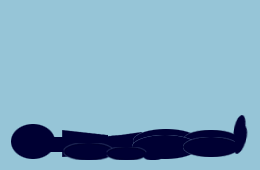
Rite two is similar to Western abdominal exercises. By raising the head to the chest, you create an extra stimulus to the solar plexus chakra and the "conception vessel" moving through the center of the trunk.
Use a thick rug or pad to protect your back as you lie on the floor. Lamas perform the rites on what Westerners call a prayer rug, which is about two feet wide and six feet long. The rug is fairly thick and is made of wool and a natural fiber. It is used solely to insulate the body from the cold floor, but since religious significance is attached to everything the Lamas do, it is called a "prayer rug."
Leg Raises:
First lie flat on the floor, face up. Fully extended your arms along your sides, and place the palms of your hands against the floor, keeping the fingers close together. Then, raise your head off the floor, tucking the chin against the chest. As you do this, lift your legs, knees straight, into a vertical position. If possible, let the legs extend back over the body, toward the head; but do not let the knees bend. Then slowly lower both the head and the legs, knees straight, to the floor. Allow all the muscles to relax, continue breathing in the same rhythm. Breathe in deeply as you lift your legs and breathe out as you lower your legs.
Upon sitting up, stretch your legs out in front of you. Starting at the thigh area, stroke down the outside of your legs with your hands until you reach your feet. Grab your feet on the outside, pulling your head as close to your straight knees as possible.
Rite 3
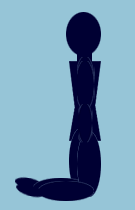
Rite three opens the solar plexus and heart. We begin life by drawing energy in through the umbilical area. Lamas believe we continue the habit of sucking into the solar plexus, which is the seat of the emotional body, without being aware of what we are taking in. All kinds of emotional energies enter in this way. Psychically, we attract negative emotions that relate to those we ourselves are carrying. Thus, fear or anger inside us acts as a magnet to people who are carrying the same kind of energies.
Contraction interferes with the functioning of the solar plexus ganglion that relays messages to the brain relevant to our sense of safety and stimulates the "fight or flight" reflex. This rite provides an extension and a powerful lifting of the entire trunk, which is the opposite of a defensive, contractive stance. By performing this motion, you are reversing the energy flow and raising the energy to the heart area.
Camel:
This is a classic back bend. Kneel on the floor, knees under your hips, toes flat, with the body erect. Place hands on back of legs just under the buttocks. Tilt the head and neck forward, tucking the chin against the chest. Then, tilt the head and neck backward, arching the spine backward, and look upward. After arching, return to the original position, and repeat up to 21 times.
Inhale deeply as you arch the spine, exhale as you return to an erect position. This rite opens up the front of the body and spine. Establish a rhythmic breathing pattern. Breathe in deeply as you arch the spine. Breathe out as you return to an erect position.
When you are finished with this series of motions, extend your arms at shoulder level straight out in front of you and lean back without arching your back. You will feel this stretching the facia lata at the outer thighs.
Rite 4
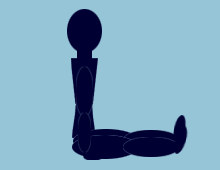
This rite causes a pleasant stimulation throughout the sacral area which stirs the meridians and the energies going to and from the groin and down the legs. This rite strengthens and tones the legs and glutes.
Tabletop:
Sit on floor with your legs extended, body erect, feet flexed and about 12 inches apart, palms flat on floor next to your hips, fingers pointed toward your feet. Tuck the chin forward against the chest. Now, tilt the head backward as far as it will go. At the same time, bend your knees and push up to a "tabletop" position, arms straight. Let your head fall back gently. The trunk of the body will be in a straight line with the upper legs, horizontal to the floor. Then, tense every muscle in the body. Finally, relax your muscles as you return to the original sitting position. Rest before repeating the procedure.
Breathe in as you raise up, hold your breath as you tense the muscles, breathe out completely as you come down. Continue breathing in the same rhythm as long as you rest between repetitions.
Rite 5
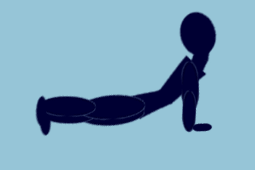
Rite five brings an immediate change in the energy currents of the body. It makes one feel strong and invigorated and brings a happy glow to the face. This is the most powerful rite in terms of speeding up the chakric vortexes.
Up Dog & Down Dog:
Begin on all fours, toes flexed, palms on floor, weight distributed evenly among your knees, your palms, and the balls of your feet. Throughout this rite, your hands and feet should be kept straight. Start with your arms perpendicular to the floor, and the spine arched downward, so that the body is in a sagging position. Slowly lift your buttocks toward the sky, with a flat back, lowering your head, so your body makes an inverted "V." Tuck your chin to your chest. Pause, then lower your buttocks while pressing your palms into the floor, until your legs are in a plank position (parallel to the ground), moving your chest out and shoulders back. Inhale on your way up; exhale on your way down. Repeat, up to 21 times. In the rite, your body is moving in concert, moving energy up the spine.
Follow the deep breathing pattern used in the previous rites. Breathe in deeply as you raise the body, breathe out fully as you lower it.
Rite 6
Tibetans say that this special sixth rite will make you into a super-being.
Deep Breathing:
Stand comfortably and exhale as you bend from the waist, placing your hands on your knees. Expel the last bit of air from your lungs and without taking in new breath, return to an erect position. Place your hands on your hips, with fingers to the front and press as hard as you can while sucking in the abdomen. This will raise your shoulders and chest. While holding in the abdomen, also squeeze the pubococcygeal muscle up to emphasize the upward thrust. Hold this position and bring your closed eyeballs to the point between the eyebrows so that all this lower chakric energy will rise up to the highest centers. When you must take a breath, breathe in through your nose and then exhale through the mouth as you drop your arms down to your sides to relax. Take in several normal breaths through the nose and mouth before beginning again.
_________________
http://www.natures-blessings.org/OrgoneFeetChakraBalancers.htm
http://psychicspiritinyou.com/balance-your-chakras-free-ebook/
http://cosmicvibes.podomatic.com/ |
|
| Back to top |
|
 |
|
|
You cannot post new topics in this forum
You cannot reply to topics in this forum
You cannot edit your posts in this forum
You cannot delete your posts in this forum
You cannot vote in polls in this forum
|
Powered by phpBB © 2001, 2002 phpBB Group
Igloo Theme Version 1.0 :: Created By: Andrew Charron |










